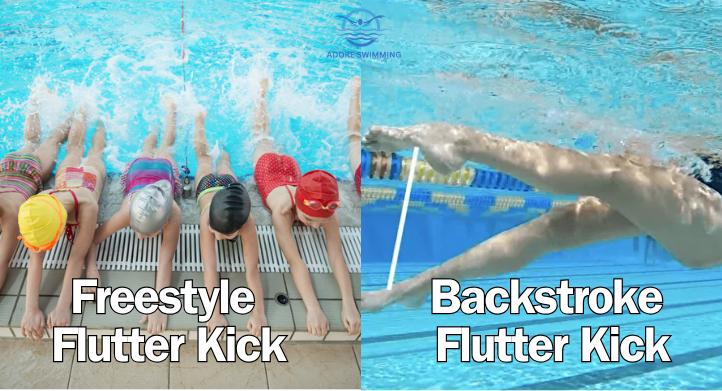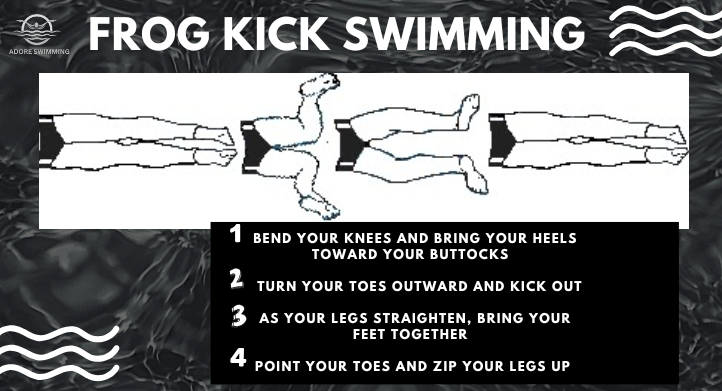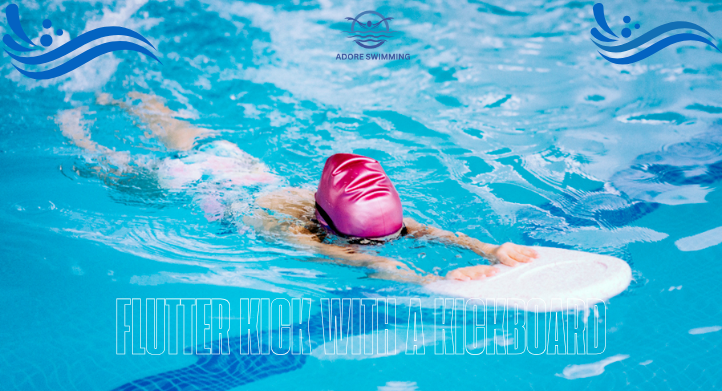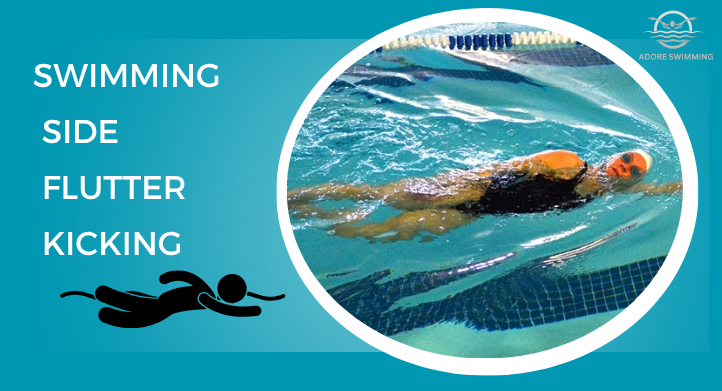How to kick when swimming for beginners? (+exercises)
A strong, well-timed kick can boost your speed in the water. Kicking helps to:
- Keep your legs near the surface
- Maintain your body’s streamline
- Prevent over-rotation
- Minimizes fatigue
If you have this question: How to kick when swimming for beginners? Take a look at the video below:
you should know that there are various kicking techniques used in different strokes:
- Flutter Kick: Utilized in freestyle and backstroke.
- Frog Kick: Common in breaststroke.
- Dolphin Kick: Used in butterfly stroke.
How to Flutter kick swimming for beginners?

Used in freestyle and backstroke. Your body should be in a horizontal position in the water.
Keep your head in line with your spine, then start kicking with your legs moving up and down. Starting the kick at the hip and not your knee is important.
Take a look at the points:
- Kick from your hips; use your thigh and butt muscles to drive the kick.
- Your legs should be straight but not rigid. A slight bend at the knee during the downward phase is natural, but excessive bending should be avoided.
- Pointing your toes helps streamline your body and reduces drag.
- Aim for rapid, small kicks rather than large, slow ones to maintain speed
I always tell the swimmers that kicking in water is like kicking a soccer ball. Water is your ball, and with your feet, you should shoot the water.
Using a kickboard can help focus on your leg movements.
How to do the Frog kick swimming for beginners?

In breaststroke, the frog kick (or whip kick) involves drawing the heels toward the body, turning the feet outward, and then pushing the legs back in a circular motion.
See the steps below to do the frog kick swimming:
- Bend your knees and bring your heels towards your buttocks.
- Turn your toes outward and start kicking out, like a frog. Keep your knees about shoulder-width apart to reduce drag.
- As your legs begin to straighten, bring your feet around and start to squeeze them back together.
- Point your toes and zip up your legs, returning to your starting position in a streamline.
Take a look at the points
- Your ankles should be very flexible.
- Keep the lower part of your body afloat.
- Doing the constant kicking is important.
How to do the dolphin kick swimming for beginners?
Not just for butterfly stroke—dolphin kicks are also used underwater after starts and turns in all competitive strokes
The dolphin kick is a wave-like motion that travels from the chest down through the hips, knees, and finally the feet.
You can practice the dolphin kicks with a wall to indicate the points where you can do the wave-like movements, as shown in the picture below:
You can also use fins to practice this kick.
What are Swimming Kick Drills?
The swimming kick drills can help you to answer this question: How to kick when swimming for beginners?
Let’s take a look at these drills:
Flutter Swimming Kick with a Kickboard

Hold a kickboard out in front of you, keeping your arms extended. Focus on small, quick kicks from the hips, with loose ankles and knees.
Swimming Flutter Kicking on Your Back

Float on your back, holding a pool noodle or float at your chest. Look at your feet and start kicking. you can also keep a kickboard between your arms and hug it, and then start kicking on your back.
Swimming Side Flutter Kicking

Extend one arm in front and keep the other at your side. Kick on your side, focusing on a steady flutter kick. This drill helps improve balance.
You can kick six times on one side, then take a stroke and switch to the other side and then do the six-kick.
Swimming Vertical Kicking
Go to the deep end, keep your hands out of the water, and kick from your hips to stay afloat.
Breaststroke (Frog) Kick Drills
- Wall or chair Drill: Hold onto the pool wall and practice the breaststroke kick, focusing on bringing your heels to your hips and turning your feet outward before pushing back. You can sit on a chair and do this.
- With a Pull Buoy: Place a pull buoy between your thighs to isolate your legs and practice the whip-like motion.
Single-Leg Flutter Kick
Kick with one leg while the other one holds still. After a set number of kicks (commonly 6–12 per leg), switch to the other leg.
What are the Dryland Exercises to Improve Freestyle Kick?
| Exercise | Target Area | Why It Helps | Sets/Reps/Duration |
|---|---|---|---|
| Ankle stretches/ABCs | Ankle flexibility | Improves toe point, reduces drag | 2–3 sets × 10–15 reps |
| Squats/Split squats | Legs, hips | Powerful kicks | 2–3 sets × 10 reps |
| Lunges | Legs, hips | Functional strength, balance | 2–3 sets × 10 reps |
| Jump squats/Box jumps | Power | Explosive strength | 2–3 sets × 10 reps |
| Prone flutter kicks | Hips, core | Mimics kick, hip drive | 2–3 sets × 30 seconds |
| Glute bridges | Glutes, hamstrings | Hip extension, core stability | 2–3 sets × 30 seconds |
| Planks/Superman | Core, lower back | Streamline, body position | 2–3 sets × 30 seconds |
FAQs
Why Can't I Kick Properly Swimming?
- You kick from the knees instead of the hips
- You bend your knee too much
- You lift your head too high so that your hips or legs sink
Do You Kick from Your Hip or Knee When Swimming?
You should kick from your hips, not your knees. The kick starts with a small movement at the hip, travels down the leg, and finishes with a "flick" of the foot.
How to Use a Kickboard in Swimming for Beginners
- Hold the kickboard at the top edge
- Keep your arms extended and relaxed on the board, and your head either in or just above the water. Keeping your face in the water helps your hips stay up and your body more horizontal
- Kick from your hips with straight legs
- Keep your kicks small and fast



Leave A Comment